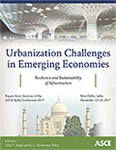ASCE India Conference 2017
Towards Seismic Resilient Bridges on an Urban Mass Rapid Transport Network
Publication: Urbanization Challenges in Emerging Economies: Resilience and Sustainability of Infrastructure
ABSTRACT
India has history of devastating earthquakes and nearly 54% of area is vulnerable to earthquakes. Bridges being the critical links of any roadways transportation network are under threat of greater seismic risk. The present study evaluates the differences in risk assessment of bridges on typical rail mass transit system network consisting of pile-pier (i.e. considering soil-structure interaction) using incremental dynamic analysis and pushover methods. The fragility curves have been developed for three limit states and the probability of failure has been derived for a PGA of 0.24 g. The results using two methodologies have been compared in terms of reliability indices which highlight the need of appropriate selection of structural analysis method for assessing the reliability. This study will aid in evolving reliable design methodology thus ensuring the performance levels and more informed pre-disaster planning strategies to avoid seismic risk of bridges.
Get full access to this article
View all available purchase options and get full access to this chapter.
ACKNOWLEDGEMENT
The financial support is provided by the DST, Govt. of India through the GAP4539 project under the title “Remote health monitoring (IRHM) system for bridges (under grant DST/TSG/STS/2011/43)”. The support provided by the Directors, CSIR-CRRI and CSIR-SERC is gratefully acknowledged.
REFERENCES
Akgul, F. and Frangopol, M. F. (2005). “Lifetime Performance Analysis of Existing Reinforced Concrete Bridges II: Application”. Journal of infrastructure system. ASCE. Vol. 11(2). 129-141.
ASCE 7 (2005). “Minimum Design Loads for Buildings and Other Structures. American Society of Civil Engineers.” USA. 2005.
ASCE 41-13. (2013). Publication Anticipated Seismic Evaluation and Upgrade of Existing Buildings. American Society of Civil Engineers. Reston. Virginia. Public Comment Edition available through the American Society of Civil Engineers.
ATC 40. (1996). Seismic evaluation and retrofit of concrete buildings. Redwood City. Proposition 122 Seismic Retrofit Practices Improvement Program Report SSC 96-01. Applied Technology Council. California seismic safety commission. U.S.A.
FEMA-273. (1997). NCEHRP Guidelines for the Seismic Rehabilitation of Buildings FEMA, Washington, D.C., USA.
FEMA: 356. (2000). Pre-Standard and Commentary for the Seismic Rehabilitation of Buildings. ASCE. Virginia. USA.
FHWA-HRT-06-032. (2006). Seismic Retrofitting Manual for Highway Structures: Part 1 - Bridges. MCEER University. Buffalo, State University of New York, New York.
Ghobarah, A. (2001). “Performance Based Design in Earthquake Engineering: State Of Development. Engineering Structures”.Elsevier Publication. Vol. 23.878-884.
Gupta, A., Shrivastava, H., Ramana, G. V. and Nagpal, A. K. (2012). Site Specific Seismic Response of Bridge Piers in Delhi Region for Far-Field and Near-Field Earthquakes. ISET Golden Jubilee Symposium Indian Society of Earthquake Technology. Department of Earthquake Engineering Building. IIT Roorkee. Roorkee. India.
IRC: 6. (2014).Standard Specifications and Code of Practice for Road Bridges: Section II Loads and Stresses. Indian Road Congress. New Delhi.
Iyengar, R. N. and Ghosh, S. (2004). “Seismic Hazard Mapping of Delhi City”.13thWorld Conference on Earthquake Engineering August 1-6. Paper No. 180. Vancouver. B.C. Canada.
McGuire, B. (2012). “Waking the giant: how a changing climate triggers earthquakes, tsunamis, and volcanoes”. Oxford University Press, New York.
Olteanu, I., Vargas, Y.F., Barbat, A.H., Budescu, M. and Pujades, L.G. (2011). “Vulnerability and Risk Evaluation for a Reinforced Concrete Frame”. Bulletin of the Polytechnic Institute of Iasi. Romania. Vol. LVII (LXI). No. 3. 9-20.
“PEER Strong-motion database”. https://peer.berkeley.edu/products/strong_ground_motion_db.html (December 25, 2016).
SAEOC Vision Committee. (1995). Performance-based seismic engineering. Report prepared by Structural engineers association of California, Sacramento, California. USA.
Vamatsikos, D. and Cornell, A. C. (2004). “Applied Incremental Dynamic Analysis”. Earthquake Spectra. Vol. 20. No. 2. 523-553.
Information & Authors
Information
Published In
Urbanization Challenges in Emerging Economies: Resilience and Sustainability of Infrastructure
Pages: 645 - 656
Editors: Udai P. Singh and G. L. Sivakumar Babu, Indian Institute of Science
ISBN (Online): 978-0-7844-8203-2
Copyright
© 2018 American Society of Civil Engineers.
History
Published online: Dec 13, 2018
Authors
Metrics & Citations
Metrics
Citations
Download citation
If you have the appropriate software installed, you can download article citation data to the citation manager of your choice. Simply select your manager software from the list below and click Download.
